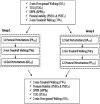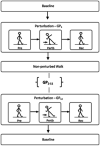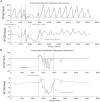Effects of protective step training on proactive and reactive motor adaptations in Parkinson's disease patients
- PMID: 37965161
- PMCID: PMC10642212
- DOI: 10.3389/fneur.2023.1211441
Effects of protective step training on proactive and reactive motor adaptations in Parkinson's disease patients
Abstract
The aim of this study was to investigate to what extent PD affects the ability to walk, respond to balance perturbations in a single training session, and produce acute short-term effects to improve compensatory reactions and control of unperturbed walking stability. Understanding the mechanism of compensation and neuroplasticity to unexpected step perturbation training during walking and static stance can inform treatment of PD by helping to design effective training regimens that remediate fall risk. Current rehabilitation therapies are inadequate at reducing falls in people with Parkinson's disease (PD). While pharmacologic and surgical treatments have proved largely ineffective in treating postural instability and gait dysfunction in people with PD, studies have demonstrated that therapy specifically focusing on posture, gait, and balance may significantly improve these factors and reduce falls. The primary goal of this study was to assess the effectiveness of a novel and promising intervention therapy (protective step training - i.e., PST) to improve balance and reduce falls in people with PD. A secondary goal was to understand the effects of PST on proactive and reactive feedback responses during stance and gait tasks. Multiple-baseline, repeated measures analyses were performed on the multitude of proactive and reactive performance measures to assess the effects of PST on gait and postural stability parameters. In general, the results indicate that participants with PD were able to use experiences with perturbation training to integrate and adapt feedforward and feedback behaviors to reduce falls. The ability of the participants with PD to adapt to changes in task demands suggests that individuals with PD could benefit from the protective step training to facilitate balance control during rehabilitation.
Keywords: Parkinson’s disease; accidental falls; feedforward and feedback; gait and balance; motor adaptability; motor learning; physical therapy; protective step training.
Copyright © 2023 Lockhart, Frames, Olson, Moon, Peterson and Lieberman.
Conflict of interest statement
The authors declare that the research was conducted in the absence of any commercial or financial relationships that could be construed as a potential conflict of interest.
Figures















References
LinkOut - more resources
Full Text Sources

